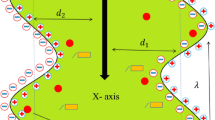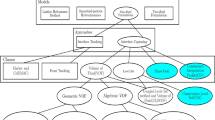Abstract
A one-dimensional discrete-sectional model has been developed to simulate particle growth in aerosol reactors. Two sets of differential equations for volume and surface area, respectively, were solved simultaneously to determine the size distributions of agglomerates and primary particles. The surface area equations were derived in such a way that the coagulation integrals calculated for the volume equations could be used for the surface area equations as well, which is new in this model. The model was applied to a production of TiO2 particles by oxidation of titanium tetrachloride. Model predictions were compared with experimental data and those of a two-dimensional sectional model. Good agreement was shown in calculated particle size distributions between the present model and the two-dimensional model, which is more rigorous but demands a large amount of computer time and memory. Compared to experimental data, the primary particle size calculated by the model was more sensitive to the variation of reactor temperature.
Similar content being viewed by others
References
Friedlander, S. K.,Smoke, dust and haze, Wiley, New York (1977).
Gelbard, F. and Seinfeld, J. H., “The general dynamic equation for aerosol,”J. Colloid Interface Sci.,68, 363 (1979).
Gelbard, F., Tambour, Y. and Seinfeld, J. H., “Sectional representation for simulating aerosol dynamics,”J. Colloid Interface Sci.,76, 541 (1980).
Graham, S. C. and Robinson, A., “A comparison on numerical solutions to the self-preserving distribution for aerosol coagulation in the free-molecular regime,”J. Aerosol Sci.,7, 261 (1976).
Jeong, J. I. and Choi, M., “A sectional method for the analysis of growth of polydisperse non-spherical particles undergoing coagulation and coalescence,”J. Aerosol Sci.,32, 567 (2001).
Koch, W. and Friedlander, S. K., “The effect of particle coalescence on the surface area of a coagulating aerosol,”J. Colloid Interface Sci.,140, 419 (1990).
Kobata, A., Kusakabe, K. and Morooka, S., “Growth and transformation of TiO2 crystallites in aerosol reactor,”AIChE J.,37, 347 (1991).
Landgrebe, J. D. and Pratsinis, S. E., “A discrete-sectional model for particulate production by gas-phase chemical reaction and aerosol coagulation in the free-molecular regime,”J. Colloid Interface Sci.,139, 63 (1990).
Matsoukas, T. and Friedlander, S. K., “Dynamics of aerosol agglomerate formation,”J. Colloid Interface Sci.,146, 495 (1991).
Moniruzzaman, C. G.,Analysis of iron particle growth by a discretesectional model, MS thesis, 2005, Department of Chemical Engineering, Kongju National University, Chungnam 314-701, Korea.
Okuyama, K., Kousaka, Y., Tohge, N., Yamamoto, S., Wu, J. J., Flagan, R. C. and Seinfeld, J. H., “Production of ultrafine metal oxide aerosol particles by thermal decomposition of metal alkoxide vapors,”AIChE J.,32, 2010 (1986).
Pratsinis, S. E., Bai, H., Biswas, P., Frenklach, M. and Mastrangelo, S. V. R., “Kinetics of titanium (IV) chloride oxidation,”J. Am. Ceram. Soc.,73, 2158 (1990).
Press, W.H., Teukolsky, S.A., Vetterling, W.T. and Flannery, B.P.,Numerical recipes in FORTRAN 77, Cambridge University Press (1992).
Rogak, S. N. and Flagan, R. C., “Coagulation of aerosol agglomerates in the transition regime,”J. Colloid Interface Sci.,151, 203 (1992).
Tsantilis, S. and Pratsinis, S. E., “Evolution of primary and aggregate particle-size distribution by coagulation and sintering,“AIChE J.,46, 407 (2000).
Ulrich, G. D., “Theory of particle formation and growth in oxide synthesis flames,”Combust. Sci. Technol.,4, 47 (1971).
Wu, J. J. and Flagan, R. C., “A discrete-sectional solution to the aerosol dynamic equation,”J. Colloid Interface Sci.,123, 339 (1988).
Xiong, Y. and Pratsinis, S. E., “Formation of agglomerate particles by coagulation and sintering-part I. A two-dimensional solution of the population balance equation,”J. Aerosol Sci.,24, 283 (1993a).
Xiong, Y. and Pratsinis, S. E., “Formation of agglomerate particles by coagulation and sintering-part II. The evoloution of the morphology of aerosol-made titania, silica and silica-doped titania powders,”J. Aerosol Sci.,24, 301 (1993b).
Author information
Authors and Affiliations
Corresponding author
Rights and permissions
About this article
Cite this article
Moniruzzaman, C.G., Park, K.Y. A discrete-sectional model for particle growth in aerosol reactor: Application to titania particles. Korean J. Chem. Eng. 23, 159–166 (2006). https://doi.org/10.1007/BF02705709
Received:
Accepted:
Issue Date:
DOI: https://doi.org/10.1007/BF02705709




